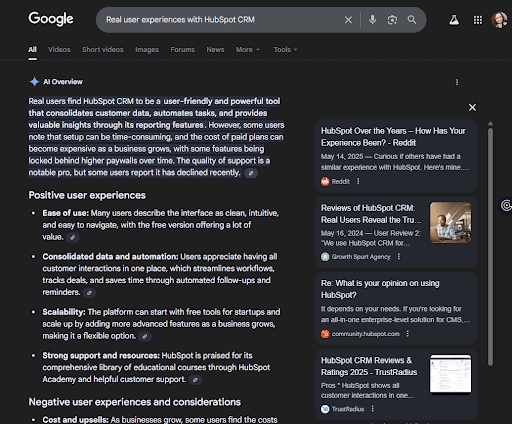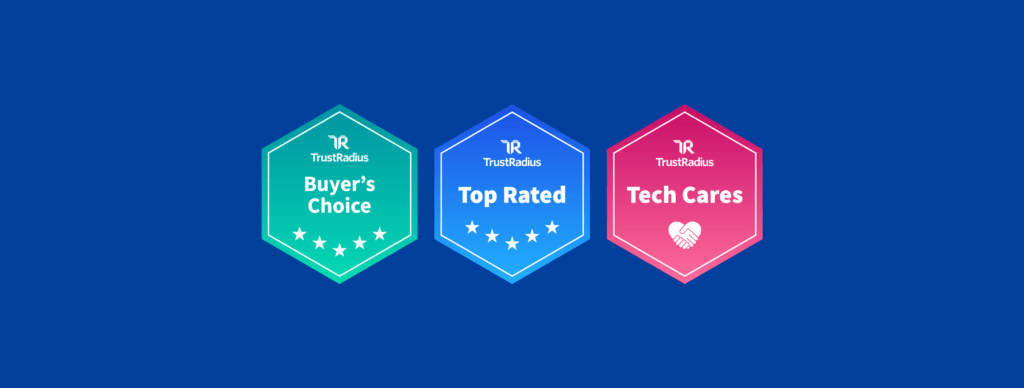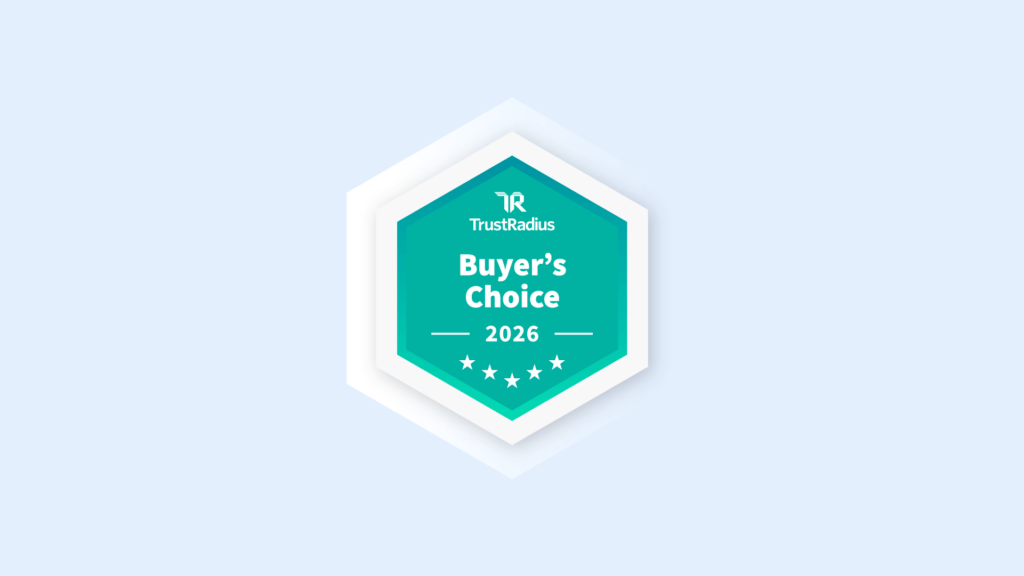Show Up Where It Counts: Understanding AI Visibility in Search
AI is doing more than changing how people write, brainstorm, or plan; it’s changing how they buy.
In two short years, tools like ChatGPT have gone from novelty to necessity, quietly reshaping the earlier stages of vendor research. Our recent report, From Buzzword to Backbone, found that 45% of all buyers, and 51% of enterprise buyers, use AI in their software-buying processes.
These modern buyers aren’t simply typing longtail keywords into search bars anymore. They’re asking full questions with context about who they are, what they’re looking for, and asking for lists of the best products for the job. When your content answers those questions clearly and consistently across channels, you’re helping shape your narrative, how you show up in AI overviews, and how you’re perceived by buyers.
In this new way of researching, it’s imperative to be useful with your content, not just optimizing your copy for algorithms. Doing so will win you both AI visibility and buyer trust.
Ranking used to be simple
We all know that visibility is a #1 goal in marketing. But as traditional search declines and AI assistants become more of the norm, visibility looks different.
It used to be: get your content ranking, optimize for discovery, and drive traffic to your site.
Now, the rules have changed: visibility isn’t tied so tightly to search engine optimization (SEO) anymore. Instead, it’s all about being credible enough to be cited in AI overviews from ChatGPT, Perpexity, and every other AI summary tool buyers are using.
That shift matters because most buyers already know what they want before they even start researching. Our 2025 B2B buyer report found:
- 82% of buyers already had a top product in mind when building their short-list.
- 70% ended up purchasing that same product
- 79% of all buyers, and 89% of enterprise buyers, knew about their chosen product before they began their research
Buyers aren’t discovering — they’re confirming. And as AI becomes the new first stop for information, those preconceptions aren’t going away. If your brand isn’t trusted, visible, and verifiable enough to appear in AI-generated results, you’re missing clicks and consideration.
The buyer journey used to start with a search results page. Today, it starts with an answer.
Google’s evolution from search engine to answer engine means most users are no longer clicking through results. They’re reading what the algorithm shows them, often AI summaries at the top of the page.
For vendors, this shift is massive. Google now sends nine times fewer clicks per scraped page than before, averaging one click for every 1,500 pages AI scans. That means that there are fewer opportunities for buyers to actually land on your website and your content. In this new process of discovery, there’s a far greater dependence on the credibility of what the algorithm chooses to show buyers.
At the same time, large language models (LLMs) like ChatGPT, Gemini, and Claude are changing how buyers gather information. These tools aren’t indexing ads or SEO-optimized pages, they’re trained on authentic, user-generated content like reviews and Reddit posts. They favor signals of trust over polish. In other words:
- AI models reward content that reflects genuine product experiences — like in-depth reviews, detailed use cases, and real-world performance insights — over marketing copy that was built to convert.
- Verified reviews and first-hand accounts carry more weight than branded assets or gated case studies. The more authentic and corroborated your presence, the more likely it is to surface.
- LLMs prioritize fresh, evolving data that mirrors what’s happening in the market now, not the same optimized talking points echoed across dozens of pages.
At TrustRadius, our content is helpful for buyers and consistently pulled into AI overviews because our structured, answer-based review pages provide the context, sentiment, and verification that LLMs recognize as credible and authoritative answers.
SEO, though still important, isn’t what it once was. Generative engine optimization (GEO) is quickly becoming the preferred research method. It’s a fundamental shift in how software buyers discover and make purchasing decisions. This means brands that want to win in SEO and GEO need to have strategies for both tactics in the playbook.
In other words, if you’re not actively shaping your product’s narrative across AI-trusted sources like TrustRadius, you’re leaving it up to the algorithm, or your competitors, to do it for you.
What does “AI visibility” mean?
Traditional visibility was about ranking high enough for someone to click. AI visibility is about being credible enough to be cited.
When buyers turn to generative tools like ChatGPT or Gemini, they aren’t scrolling through lists of links anymore. Instead, buyers are reading synthesized answers. Those answers come from a select set of trusted, high-signal sources that AI systems can crawl, verify, and reuse. That’s what makes AI visibility different: it’s about being seen by humans and being understood by machines.
AI visibility is based on four key factors:
- Authority: Algorithms prioritize sources that have earned trust. Domains with verified reviews, clear product metadata, and consistent backlinks from reputable sites are recognized as authoritative.
- Authenticity: AI systems can see the difference between polished marketing copy and genuine user insight. Long-form, user-generated reviews provide the kind of lived experience that machines treat as reliable evidence.
- Recency: Fresh content signals reliability. When reviews and product pages are regularly updated, they tell AI models that your data reflects the current state of your offering.
- Representation: Consistent messaging across all AI-visible sources helps reinforce what your product is known for. Disjointed claims or outdated copy dilutes credibility in both search and generative answers.
How does AI rate TrustRadius for credibility?
Generative AI models don’t browse the web like people do. Instead, they digest it. And when that happens, structured websites like TrustRadius stand out. Each review, rating, and product detail is encoded in a consistent format that algorithms can easily interpret.
Instead of treating a TrustRadius page as marketing material, AI models recognize it as structured, verifiable buyer insight. That structure allows systems to connect data points — what products do, how they perform, and how real users describe them — and reframe them into relevant answers.
That’s why TrustRadius content is both indexed in search results and cited in the very tools shaping how buyers research, compare, and decide.
Why TrustRadius matters for AI visibility
LLMs and AI-powered tools rely on structured, authentic content to provide answers, and user-generated reviews are the highest-signal source for these algorithms. Unlike polished marketing copy, reviews on TrustRadius reflect real-world experiences, successes, and limitations. It’s exactly the kind of information AI systems need in order to generate trustworthy recommendations.
With 21.7% of all AI-generated citations on Google relying on user-generated content (UGC), nearly a quarter of the information buyers see first is pulled from authentic, user-driven sources — the very content TrustRadius provides.
In practical terms, a well-maintained TrustRadius profile can serve as an organic path to AI visibility. TrustRadius is:
- Cited in generative answers. LLMs pull structured insights directly from TrustRadius reviews when compiling recommendations.
- Amplified through GEO. As buyers ask AI tools for comparisons, snippets referencing verified reviews boost your credibility in AI-generated outputs.
- Trusted by buyers. Peer-generated content resonates with decision-makers more than marketing copy, increasing confidence and shortening the research process.
Here’s a real-world example of AI crawling TrustRadius to create an AI-generated summary:
Your presence on TrustRadius doesn’t just influence buyers when they go on your product’s page, it trains the algorithm. By pairing a review-rich profile with content aligned to buyer priorities, you can create an organic, AI-friendly path for your product to be cited, surfaced, and trusted without buyers ever having to click onto your website.
Find out how to optimize your TrustRadius product profile page and get the most out of your presence on the platform. This will help you show up for buyers on TrustRadius and AI tools crawling our site for answers to buyer questions in other channels. Read How to improve visibility and reach more in-market buyers on TrustRadius.




















